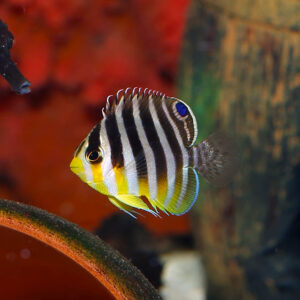The Oriental Butterfly (Chaetodon auripes) is a visually striking fish with a maximum size of up to 6 inches (15 cm). It boasts a vibrant yellow body adorned with bold dark stripes and markings. Its elegant and elongated fins add to its overall grace and beauty.
Natural Habitat:
In its natural habitat, the Oriental Butterfly inhabits coral reefs and rocky areas with abundant hiding spots and crevices. These areas provide the fish with shelter and protection. The reefs are teeming with diverse marine life, colourful corals, and swaying seagrass beds. The warm, tropical waters they inhabit offer a plethora of food sources, ensuring their survival in the wild.
Keeping Oriental Butterfly Healthy:
The Oriental Butterfly requires careful attention and is considered to have a moderate to difficult care level. It is crucial to maintain stable water parameters within the temperature range of 75-82°F (24-28°C). Regular monitoring of pH levels, which should be maintained between 8.1-8.4, is essential. Additionally, a carbonate hardness (KH) range of 8-12 dKH should be maintained. These delicate fish thrive in well-established aquariums with excellent filtration and consistent water quality.
Special Requirements and Feeding:
Oriental Butterflies have specific dietary requirements. They are classified as omnivorous and prefer a diet consisting of live or frozen foods such as brine shrimp and mysis shrimp. High-quality prepared foods, including flakes and pellets, can also be offered. Ensuring a varied and nutritious diet is vital for their overall health and well-being.
How Many Should I Keep:
It is recommended to keep Oriental Butterflies individually or in pairs due to their territorial nature. Keeping multiple individuals may lead to aggression and stress. Providing each fish with ample space to swim and establish their territory is crucial for their overall happiness and health.
Lighting Preference:
The Oriental Butterfly thrives in aquariums with moderate to high lighting. Adequate lighting not only enhances their vibrant colouration but also supports the growth of beneficial microorganisms and the overall health of live plants within the aquarium.
Suitable Tank Mates:
When considering tank mates for The Oriental Butterfly, it is crucial to choose peaceful species that can coexist harmoniously. Avoid pairing them with aggressive or overly territorial fish. Ideal tank mates include peaceful community fish such as small gobies, peaceful wrasses, and other non-aggressive reef-safe species. Careful observation and compatibility checks should be conducted before introducing any new tank mates.
Reproduction in the Wild:
In the wild, the Oriental Butterfly (Chaetodon auripes) reproduces through a process known as broadcast spawning. During spawning, males and females release their eggs and sperm simultaneously into the water column. This synchronized release increases the chances of fertilization and ensures a higher survival rate for the offspring.
Breeding Chaetodon auripes:
- Set up:
To breed the Oriental Butterfly in captivity, you will need a well-maintained and spacious aquarium with stable water parameters. Provide ample hiding spots and live rock for the fish to establish territories and deposit eggs.
- Courtship/Spawning:
Oriental Butterflies engage in elaborate courtship displays to attract a mate. The male fish will display vibrant colours, perform intricate swimming patterns, and even exhibit fin flaring. Once a pair has formed, they will select a suitable spawning site within the aquarium.
- Rearing:
After spawning, the fertilized eggs will float in the water column. It is crucial to remove the eggs from the main aquarium to a separate rearing tank or specialized breeding apparatus. Maintain optimal water conditions, including appropriate temperature and lighting. The eggs will hatch within a few days, and the larvae will undergo various developmental stages. Provide them with suitable live food, such as rotifers and newly hatched brine shrimp, to support their growth.
Sexual Dimorphism:
The Oriental Butterfly does not exhibit significant sexual dimorphism. Both males and females possess the same vibrant colouration and overall appearance. Therefore, visual cues alone may not be reliable indicators of sex in this species.
Distribution:
The Oriental Butterfly, Chaetodon auripes, is a naturally occurring fish species in the Indo-Pacific region. However, it is important to note that there are captive-bred and line-bred strains of this species available in the aquarium trade. The original wild fish are found in various areas of the Indo-Pacific, including the Red Sea, Maldives, and the Great Barrier Reef.
Summary:
The Oriental Butterfly (Chaetodon auripes) is a captivating fish species known for its vibrant colouration and graceful swimming. Breeding this species in captivity requires careful attention to water parameters, courtship displays, and proper rearing techniques. While sexual dimorphism may not be apparent, these fish are naturally found in the Indo-Pacific region. By understanding their unique reproductive behaviours and providing suitable conditions, aquarists can enjoy the joy and satisfaction of successfully breeding Oriental Butterflies in their own aquariums.





Reviews
There are no reviews yet.